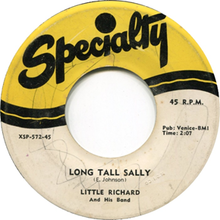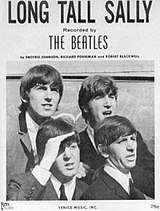Long Tall Sally
| "Long Tall Sally" | ||||
|---|---|---|---|---|
 | ||||
| Single by Little Richard | ||||
| from the album Here's Little Richard | ||||
| B-side | "Slippin' and Slidin'" | |||
| Released | March 1956 | |||
| Recorded | February 10, 1956 | |||
| Studio | J&M, New Orleans, US | |||
| Genre | Rock and roll | |||
| Length | 2:10 | |||
| Label | Specialty | |||
| Songwriter(s) |
| |||
| Producer(s) | Robert Blackwell | |||
| Little Richard singles chronology | ||||
| ||||
"Long Tall Sally" is a rock and roll song written by Robert "Bumps" Blackwell, Enotris Johnson, and Little Richard. Richard recorded it for Specialty Records, which released it as a single in March 1956, backed with "Slippin' and Slidin'".
The single reached number one on the Billboard rhythm and blues chart, staying at the top for six of 19 weeks,[1] while peaking at number six on the pop chart. It received the Cash Box Triple Crown Award in 1956.[2] The song as sung by Little Richard is #55 on Rolling Stone's list of The 500 Greatest Songs of All Time.[3] It also ranked at number 45 on Billboard's year-end singles of 1956.[4]
It became one of the singer's best-known hits and has become a rock and roll standard covered by hundreds of artists,[5] including Elvis Presley and the Beatles.
History
"Tutti Frutti" had been a big hit for Little Richard and Specialty in early 1956, reaching number two in the R&B charts. Pat Boone's cover version of the song reached number 12 in the pop charts. Although this meant an unexpected cash income for the Specialty publishing firm, A&R man and producer "Bumps" Blackwell and a proud Richard decided to write a song that was so up-tempo and the lyrics so fast that Boone would not be able to handle it (Boone eventually did record his own version, however, which reached number 18[6]).[1]
According to Blackwell, he was introduced to a little girl by Honey Chile, a popular disc-jockey. Apparently, the girl had written a song for Little Richard to record so she could pay the treatment for her ailing aunt Mary. The song, actually a few lines on a piece of paper, went like this:
Saw Uncle John with Long Tall Sally
They saw Aunt Mary comin'
So they ducked back in the alley
Not wishing to upset an influential disc-jockey, Blackwell accepted the offer and took the idea to Richard, who was reluctant at first. Nevertheless, the line "ducked back in the alley" was exactly what they were looking for, and Richard kept practicing until he could sing it as fast as possible. They worked on the song, adding verses and a chorus, until they got the hit they wanted.[7] The credit to Enotris Johnson, Richard's adoptive father, was added, probably as an act of benevolence. Featuring a tenor saxophone solo by Lee Allen (as did "Tutti Frutti"), "Long Tall Sally" was the best-selling 45 of the history of Specialty Records.
Recording
The recording session took place on February 10, 1956 at J&M Studio in New Orleans, the legendary studio owned by Cosimo Matassa on the corner of Rampart and Dumaine where Fats Domino and many other New Orleans luminaries recorded. "Long Tall Sally", as well as many other Little Richard sides, was also recorded there.
The music was a fast uptempo number with Little Richard's hammering, boogie piano. Richard plays staccato straight eighth notes while drummer Palmer plays a fast shuffle. The shuffle was the most common rhythm and blues beat; Richard added the straight eighth notes, much less common in that time, although now standard for rock music. Together this created an ambiguity in the ride rhythm—known to musicians as "playing in the crack" that came to characterize New Orleans (and also Chuck Berry) rock and roll. In typical Little Richard style, he sang in the key of F, in a raw, aggressive, exhilarating style with lyrics being about self-centered fun.[5]
Well, Long Tall Sally
She's built for speed
She's got everything that Uncle John needs
Although the lyrics are light-weight, Little Richard's style triumphs over content and provides a wonderful vehicle for his enthusiastic exhibitionism.[8]
Personnel
- Little Richard – vocals, piano
- Lee Allen – tenor saxophone
- Alvin "Red" Tyler – baritone saxophone
- Frank Fields – double bass
- Earl Palmer – drums
- Edgar Blanchard – guitar
The Beatles version
| "Long Tall Sally" | |
|---|---|
 Sheet music cover | |
| Song by the Beatles | |
| from the EP Long Tall Sally | |
| Released | June 19, 1964 |
| Recorded | March 1, 1964 |
| Studio | EMI, London |
| Genre | Rock and roll |
| Label | Parlophone |
| Songwriter(s) |
|
| Producer(s) | George Martin |
| Long Tall Sally track listing | |
4 tracks | |
The Beatles were great admirers of Little Richard, and recorded many of his songs during their career. "Long Tall Sally" was the most durable song in their live repertoire, lasting from their earliest days as the Quarrymen in 1957 through to their last public concert in August 1966. As with the majority of their Little Richard remakes, Paul McCartney sang lead vocals, as he could closely imitate Richard's vocal style.[9]
The group recorded "Long Tall Sally" at EMI Studios in London on March 1, 1964, during sessions for A Hard Day's Night, although it was ultimately not included on that album. The recording was produced by the Beatles' regular producer, George Martin, who also played piano on the track. Given the group's familiarity with the song, the recording was completed in a single take.[9]
In the United Kingdom, the song was released on the Long Tall Sally EP on 19 June 1964; however, it had been released earlier on two overseas albums, The Beatles' Second Album in the United States on 10 April 1964, and The Beatles' Long Tall Sally in Canada on 11 May 1964. Released as a single in Sweden, the song topped the Kvällstoppen Chart in July and August.[10]
The song appears on the film Backbeat. Upon viewing it, Paul McCartney was reported to say:
One of my annoyances about the film Backbeat is that they've actually taken my rock 'n' rollness off me. They give John "Long Tall Sally" to sing and he never sang it in his life. But now it's set in cement. ['Paul' sang Long Tall Sally in the Glasgow stage version]. It's like the Buddy Holly and Glenn Miller stories. The Buddy Holly Story does not even mention Norman Petty, and The Glenn Miller Story is a sugarcoated version of his life. Now Backbeat has done the same thing to the story of the Beatles. I was quite taken, however, with Stephen Dorff's astonishing performance as Stu.[11]
Personnel
- Paul McCartney – vocals, bass
- John Lennon – rhythm guitar
- George Harrison – lead guitar
- Ringo Starr – drums
- George Martin – piano[9]
Other Beatles recordings and performances
In addition to their studio recording of the song, the Beatles recorded "Long Tall Sally" for BBC radio broadcasts on seven occasions during 1963 and 1964.[12] Two of these versions have been officially released, on the compilation albums Live at the BBC (1994) and On Air – Live at the BBC Volume 2 (2013). In addition, a studio version prerecorded specially from the 1964 television special Around the Beatles was included on the Anthology 1 compilation (1995). The live album The Beatles at the Hollywood Bowl (1977) includes a 1964 concert recording of the song.
"Long Tall Sally" was the last song the Beatles ever performed live in front of a paying audience. The song was a frequent set closer during their 1966 world tour—which would turn out to be their last—and they used it to close out their final show at San Francisco's Candlestick Park on August 29, 1966. The band asked their press officer, Tony Barrow, to make an audio tape recording of the concert for posterity (the recording has since circulated heavily among bootleggers), but the 30-minute tape ran out at the end of the second verse of "Long Tall Sally"—making the last moments of the Beatles' final live show lost to history.[13]
Notes
- ^ a b "Long Tall Sally". Rolling Stone. Archived from the original on October 2, 2007. Retrieved November 25, 2007.
- ^ "Little Richard". Kolumbus.fi. Retrieved August 21, 2011.
- ^ "The RS 500 Greatest Songs of All Time". Rolling Stone. Archived from the original on April 16, 2007. Retrieved June 2, 2007.
- ^ "Top 100 Songs of 1956 - Billboard Year End Charts". Archived from the original on January 7, 2019. Retrieved January 7, 2019.
- ^ a b Gillett, Charlie (1996). The Sound of the City: The Rise of Rock and Roll ((2nd Ed.) ed.). New York, N.Y.: Da Capo Press. p. 26. ISBN 0-306-80683-5.
- ^ "All US Top 40 Singles for 1956". Top40Weekly.com. Retrieved January 7, 2019.
- ^ White, Charles (2003). The Life and Times of Little Richard. The Authorised Biography. London: Omnibus Press. pp. 60–62. ISBN 0-711997616.
- ^ Shaw, Arnold (1978). Honkers and Shouters. New York: Macmillan Publishing Company. pp. 189–193. ISBN 0-02-061740-2.
- ^ a b c MacDonald, Ian (2008). Revolution in the Head: The Beatles' Records and the Sixties (3rd revised ed.). London: Vintage. p. 112. ISBN 9780099526797.
- ^ "Swedish Charts 1962–March 1966/Kvällstoppen – Listresultaten vecka för vecka > Juli 1964" (PDF) (in Swedish). hitsallertijden.nl. Retrieved June 27, 2018.
- ^ "Beatles Musical "Backbeat" Opening In L.A. Before Broadway Run". Archived from the original on March 5, 2016. Retrieved December 22, 2017.
- ^ Lewisohn, Mark (1996). The Complete Beatles Chronicle. London: Chancellor Press. p. 356. ISBN 1851529756.
- ^ Lewisohn, Mark (1996). The Complete Beatles Chronicle. London: Chancellor Press. p. 230. ISBN 1851529756.
External links
- 1956 singles
- Billboard Hot R&B/Hip-Hop Songs number-one singles
- Little Richard songs
- The Beatles songs
- 1964 debut singles
- The Kinks songs
- Elvis Presley songs
- Pat Boone songs
- Jerry Lee Lewis songs
- Eddie Cochran songs
- Buzz Clifford songs
- Grammy Hall of Fame Award recipients
- Songs written by Robert Blackwell
- Songs written by Little Richard
- Song recordings produced by George Martin
- Song recordings produced by Robert Blackwell
- Song recordings produced by Shel Talmy
- Specialty Records singles
- 1956 songs
